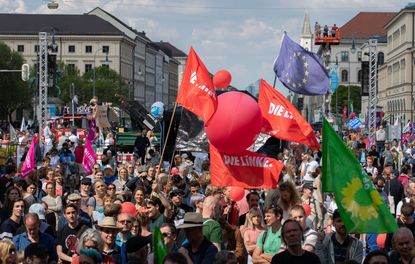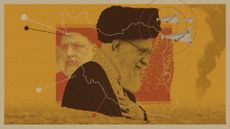What is behind the EU election’s ‘green wave’?
Europe’s Green parties surged unexpectedly in last week’s elections, squeezing the centre and confronting the populist nationalists


Europe’s Green parties pulled off one of the only great surprises of last week��s European elections, increasing their number of MEPs from 51 to 69 - nearly 40% - to emerge as a voting bloc with game-changing new power.
In what some commentators have dubbed a “green wave”, Die Grunen doubled their vote in Germany, coming second to Angela Merkel’s Christian Democrats, while Greens finished second in Finland, third in Belgium and France, and swelled in Austria, the UK, Ireland and the Netherlands.
Europe’s traditional parties of the centre contracted, losing 70 seats and their majority in parliament, though while Euro-sceptic populists won big in Italy, Hungary, and France, as the New York Times reflects, “it was not the deluge that many traditionalists had feared.”
Subscribe to The Week
Escape your echo chamber. Get the facts behind the news, plus analysis from multiple perspectives.

Sign up for The Week's Free Newsletters
From our morning news briefing to a weekly Good News Newsletter, get the best of The Week delivered directly to your inbox.
From our morning news briefing to a weekly Good News Newsletter, get the best of The Week delivered directly to your inbox.
Instead, given populists’ antagonism to the European project, and fragmentation over issues such as their stance on Russia and LGBTQ rights, the Greens are likely now be central to passing legislation, and as a result wield significant parliamentary leverage.
“We have been in a transactional mode so far,” Philippe Lamberts, co-president of the Greens, told the Financial Times. “Now we have the chance to be in a more stable relationship [with other political groups]. We want to be closer to the source of the legislation."
Ska Keller, the group’s other co-president, was clear about their agenda. “It’s a big task and a great responsibility to now put voters’ trust into concrete action to concrete climate protection, into promotion of the social Europe, as well as democracy in the rule of law – here into practice in the European parliament,” she said.
While in the UK the Liberal Democrats were resuscitated as a political force by standing as the clearest counterpoint to the nationalist right, there is a consensus that elsewhere in Europe, Green parties that have played that part. “It is not just that the populists often side with climate deniers”, reflects the Telegraph. “On almost every issue, the Greens are their diametric opposite. While the populists are Eurosceptic, anti-immigrant and nationalist, the Greens are Europhile, immigrant friendly and cosmopolitan.”
In Germany, the Greens have been so successful that Alternative for Germany (AfD) leader Alexander Gauland declared that the party now represented “our main enemy.”
The Independent dives deeper on the the demographics driving the surge: “gains for the parties, which are generally pro-EU, environmentalist, and left-leaning, appear to have mostly been concentrated in urban areas and amongst younger voters. An exit poll in France had Les Verts topping the votes of the 18-24 age group with 22 per cent, well ahead of the other parties. In Germany, the same age group showed 34 per cent voting Green – with the next largest party, Angela Merkel’s CDU, on 11 per cent.”
“Our voters, especially the younger generation, for many of whom we are now their first choice, are deeply concerned about the climate crisis, and they are pro-European – but they feel the EU is not delivering”, Bas Eickhout, a Dutch MEP, told the Guardian. “They want us to change the course of Europe.”
The new Green agenda is less hard left, and more cosmopolitan than its older iteration. Its voters have grown up in global cities and are less sceptical about open economies. This spirit is particularly alive in the German Green movement, writes Richard Ogier in the Independent, who argues that given their resounding success, theirs is the blueprint to follow if the green wave is to bring permanent change.
“The way forward, perhaps, is to join the passion of old green radicalism to the more contemporary, inclusive German approach. To seek what French political scientist Antoine Colombani has called 'virtuous interactions' between market forces and government policies for transformative change.”
Create an account with the same email registered to your subscription to unlock access.
Sign up for Today's Best Articles in your inbox
A free daily email with the biggest news stories of the day – and the best features from TheWeek.com
William Gritten is a London-born, New York-based strategist and writer focusing on politics and international affairs.
-
 Grindr 'shared user HIV status' with ad firms, lawsuit claims
Grindr 'shared user HIV status' with ad firms, lawsuit claimsSpeed Read LGBTQ dating app accused of breaching UK data protection laws in case filed at London's High Court
By Rebecca Messina, The Week UK Published
-
 The best dog-friendly hotels around the UK
The best dog-friendly hotels around the UKThe Week Recommends Take a break with your four-legged friend in accommodation that offers you both a warm welcome
By Adrienne Wyper, The Week UK Published
-
 Shopping trolleys: the new must-have accessory
Shopping trolleys: the new must-have accessorySpeed Read Sales are soaring as new designs help shed that old-fashioned image
By Adrienne Wyper, The Week UK Published
-
 Myanmar: the Spring Revolution and the downfall of the generals
Myanmar: the Spring Revolution and the downfall of the generalsTalking Point An armed protest movement has swept across the country since the elected government of Aung San Suu Kyi was overthrown in 2021
By The Week Staff Published
-
 Israel hits Iran with retaliatory airstrike
Israel hits Iran with retaliatory airstrikeSpeed Read The attack comes after Iran's drone and missile barrage last weekend
By Peter Weber, The Week US Published
-
 Is there a peaceful way forward for Israel and Iran?
Is there a peaceful way forward for Israel and Iran?Today's Big Question Tehran has initially sought to downplay the latest Israeli missile strike on its territory
By Sorcha Bradley, The Week UK Published
-
 Sudan on brink of collapse after a year of war
Sudan on brink of collapse after a year of warSpeed Read 18 million people face famine as the country continues its bloody downward spiral
By Peter Weber, The Week US Published
-
 How powerful is Iran?
How powerful is Iran?Today's big question Islamic republic is facing domestic dissent and 'economic peril' but has a vast military, dangerous allies and a nuclear threat
By Harriet Marsden, The Week UK Published
-
 US, Israel brace for Iran retaliatory strikes
US, Israel brace for Iran retaliatory strikesSpeed Read An Iranian attack on Israel is believed to be imminent
By Peter Weber, The Week US Published
-
 How green onions could swing South Korea's election
How green onions could swing South Korea's electionThe Explainer Country's president has fallen foul of the oldest trick in the campaign book, not knowing the price of groceries
By Sorcha Bradley, The Week UK Published
-
 Ukraine's battle to save Kharkiv from Putin's drones
Ukraine's battle to save Kharkiv from Putin's dronesThe Explainer Country's second-largest city has been under almost daily attacks since February amid claims Russia wants to make it uninhabitable
By Sorcha Bradley, The Week UK Published